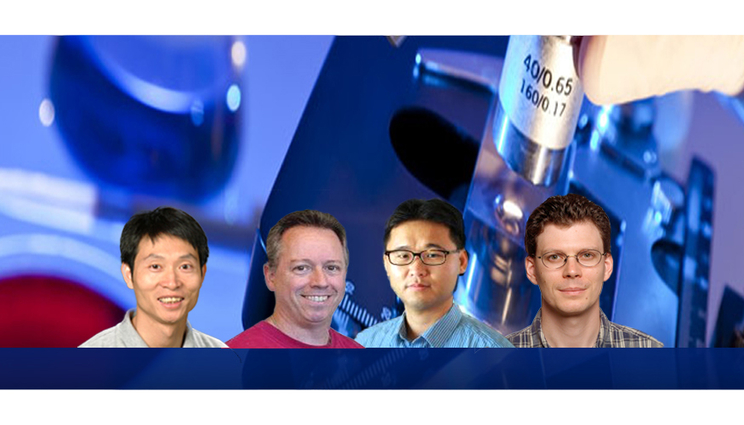UCOP awards grants and fellowships to collaborate with Lawrence Livermore
 (Download Image)
The University of California Office of the President recently awarded $7.9 million in research grants and two in-residence graduate fellowships to Lawrence Livermore National Laboratory scientists. From left, Yimin (Morris) Wang, Frank Graziani, Thomas Yong-Jin Han and Philip Cameron-Smith.
(Download Image)
The University of California Office of the President recently awarded $7.9 million in research grants and two in-residence graduate fellowships to Lawrence Livermore National Laboratory scientists. From left, Yimin (Morris) Wang, Frank Graziani, Thomas Yong-Jin Han and Philip Cameron-Smith.
The University of California Office of the President awarded more than $14 million to four grants and four graduate fellowships to collaborate with staff scientists at Lawrence Livermore and Los Alamos national laboratories.
UC scientists received $7.9 million to work with Lawrence Livermore researchers on two of the research grants and two in-residence graduate fellowships. The award is part of the UC National Laboratory Fees Research Program aimed at enhancing UC collaborations on biological applications of advanced computing, high energy density science and mesoscale materials science with LLNL and Los Alamos National Laboratory (LANL).
Farhat Beg from UC San Diego in partnership with Frank Graziani from LLNL will lead one of the new projects. Their proposal focuses on creating a new Center for Frontiers in High Energy Density Science and will receive $4.1 million over three years to study the fundamentals of nuclear physics, planetary science and astrophysics. The field of high energy density science examines material properties and physical processes under extreme conditions that exist from the interior of stars to fusion energy. Other contributors are from UC Berkeley, UC Davis, UCLA, UC Santa Cruz and LANL.
The new multi-campus UC center will integrate with LLNL’s Center for High Energy Density Science (CHEDS) with the goal of having students, postdocs and faculty come to LLNL to use DOE facilities and develop technical collaborations.
"The project will enable transformative research and technical development by partnering UC campuses with Department of Energy (DOE) partners by novel use of DOE facilities, unique research and technical collaborations between UC and DOE scientists, and by deepening connections between theory, experiment, computation and applications," said physicist and LLNL lead investigator Graziani.
Chee Wei Wong from UCLA will lead the second project in collaboration with Yimin (Morris) Wang at LLNL. "Mesoscopic 2D Materials: Many-body Interactions & Applications" will receive $3.7 million to examine atomic-scale semiconductor optoelectronics, technology where electronics interact with light. LLNL will provide state-of-the-art defect and electronic characterizations of 2D materials that offer critical links between the structure and performance of devices made by these super-thin materials that have only a single layer of atoms. Other collaborators include UC Berkeley, UCLA, UC Merced, UC Riverside, UC Santa Barbara, Lawrence Berkeley National Laboratory and LANL.
"This grant provides a nexus to further advance the fundamental science in two-dimensional materials. It uniquely combines the world-leading expertise at the national labs with four UC campuses. The strong interactions provide grounds for new discoveries, with specific applications in mesoscopic-scale optoelectronics, photovoltaics and communications," Wong said.
"The award offers some of the most exciting opportunities to team up with renowned UC faculty and advance some of the most important sciences in 2D materials," Wang added. "It also provides a channel for our Lab to educate and recruit some of the most talented students on UC campuses."
The two UC students selected for in-residence graduate fellowships are Julie Soderlind from UC Davis and James Stinecipher from UC Merced.
Soderlind will work under the mentorship of Functional Material Synthesis and Integration Group Leader Thomas Yong-Jin Han on her project and dissertation entitled, "Magnesium Scaffolds for Biomedical Implant Applications." The project will study the properties of magnesium (Mg) alloy-based biomedical implants structures created using additive manufacturing processes and compare the properties to traditionally manufactured Mg alloy biomedical implants. Improved manufacturing processes can potentially improve the quality and longevity of implants.
Han has successfully mentored many graduate students and is excited to have Soderlind win the fellowship. "Mentorship is an important part of being a scientist, perhaps even greater than meeting a milestone or making a new discovery. I am here today as a scientist and a mentor due to many great mentors I have had over my career. I have had the privilege of mentoring many great young researchers and students, and the experience has truly been fulfilling and educational," Han said.
Stinecipher will work with Climate Modeling & Analysis Group Leader Philip Cameron-Smith on his project and dissertation, "Modeling Tropical Carbon Fluxes via Carbonyl Sulfide Uptake." Stinecipher will study if increasing photosynthesis (removes carbon dioxide) or increased respiration (releases carbon dioxide) is the bigger response from the biosphere to increases in atmospheric CO2.
"Measuring CO2 only provides the net effect of these two large fluxes. In contrast, this project will use carbonyl sulfide (OCS) measurements from the Amazon. Since OCS is taken up by the plant but not respired, we should be able to determine photosynthesis and respiration separately," Cameron-Smith said. "It is exciting to see the enthusiasm of the next generation of scientists."
Annie Kersting, director for University Relations and Science Education, oversaw the call and was excited to see both the significant number of strong proposals that went forward and LLNL’s success in receiving the awards. "I look forward to seeing an increase in UC-LLNL collaborations as a result of these awards" Kersting said.
Contact
Kate Hunts[email protected]
925-422-1322
Related Links
University of California Office of the PresidentUC National Laboratory Fees Research Program
Los Alamos National Laboratory
LLNL’s Center for High Energy Density Science
Tags
High-Energy-Density ScienceCenter for High Energy Density Science
Physical and Life Sciences
Science
Featured Articles







